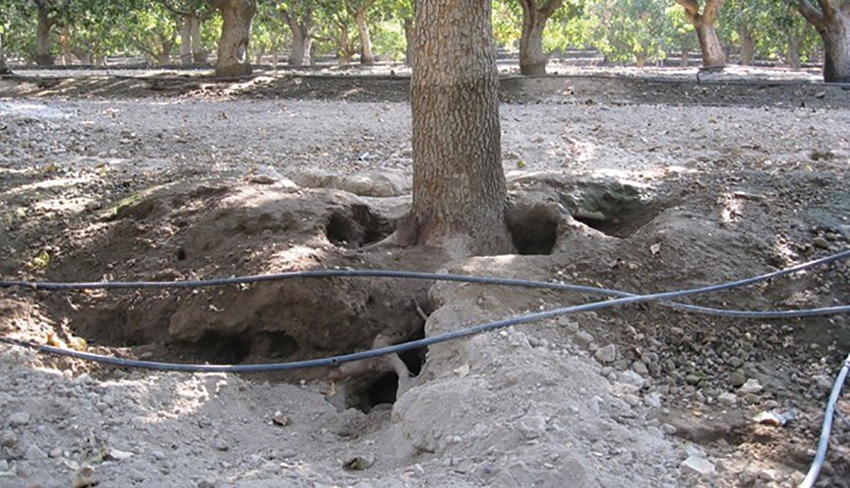
It’s somewhat like the obnoxious uncle in the family who shows up during holiday festivities; you know it’s going to happen, but you definitely don’t appreciate the appearance when it does.
Compare that unwelcome holiday company to ground squirrels in nut orchards that show up to feast on crop leftovers (as well as in nearby fruit, vegetable, and grain farm fields). Within the tree nut industry, ground squirrel burrowing can damage tree root systems (and irrigation systems) resulting in major erosion problems. Where there are lots of large burrow openings, there are lots of hazards for both workers and equipment.
Although they generally hibernate during the cooler months, climate change has brought about earlier-later-warmer areas that allows for year-round activity. The nuisance factor has become more of a nuisance, enough so that the University of California Cooperative Extension and the San Luis Obispo County Agricultural Commissioner felt the need to present a free squirrel control workshop for commercial agriculture members.
Just as there are many ways to minimize/eradicate the problem, there are many timing opportunities for greater effectiveness. Fumigants work best from mid-January to mid-May while toxic baits have high efficacy starting in mid-May, according to University of California Agriculture and Natural Resources bulletins.
“Some control methods and materials can only be used by certified or license pesticide applicators,” the UCANR folks explain. “Several factors influence the effectiveness of a control method. Management plans should incorporate site-specific variables such as cost, labor, and potential restrictions like risks to non-targets and proximity to structures. Control method success depends on the season and California ground squirrels are less likely to take toxic baits if they are still feeding on green vegetation.”
Post-harvest orchard clean-up activities deprive the squirrels of food forage opportunities and make bait options more attractive.
Not game mammals
Ground squirrels, mottled brown with gray-flecks (not to be confused with game mammals like gray tree squirrels) make their homes in underground burrows for shelter and rearing their young. Although ground squirrels can climb trees, their first instinct is to retreat to their burrow which can be a single tunnel as long as 30 feet or a part of a complex branching system.
Because they are classified as non-game mammals, they can be controlled in any legal manner (if they are) injuring crops or other property with no license required for their management if it is the property owner or tenant who is taking on the damaging squirrels.
University of California Integrated Pest Management recommendations note: “Effective management depends heavily on understanding the life cycle and behavior of the animal --- burrow fumigation is more effective in the spring when moist soil helps seal gasses in the burrow system.
The university continues: "Fumigating at this time is also more effective in reducing ground squirrel numbers since squirrels die before they can reproduce. (Mating can start as early as January in warmer locations). Do not fumigate in the summer when the soil is dry or during hibernation because squirrels plug the burrow with soil, preventing fumes from reaching the next chamber.”
Toxic baits or FGARs (first-generation anticoagulant rodenticides) require up to four weeks or more to control populations. Baiting should be continued until all feeding ceases and no squirrels are seen. Toxic grain baits containing zinc phosphide need to be applied by licensed pest management professionals.
For more news on tree nuts as reported by growers and farm advisors, subscribe to the Tree Nut Farm Press e-newsletter.
Read more about:
Ground Squirrel BurrowingAbout the Author(s)
You May Also Like




